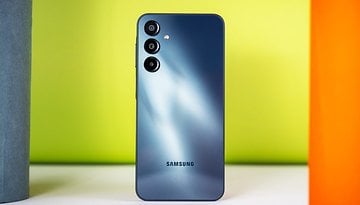Poll of the week: Do you care about the Snapdragon vs Exynos debate?
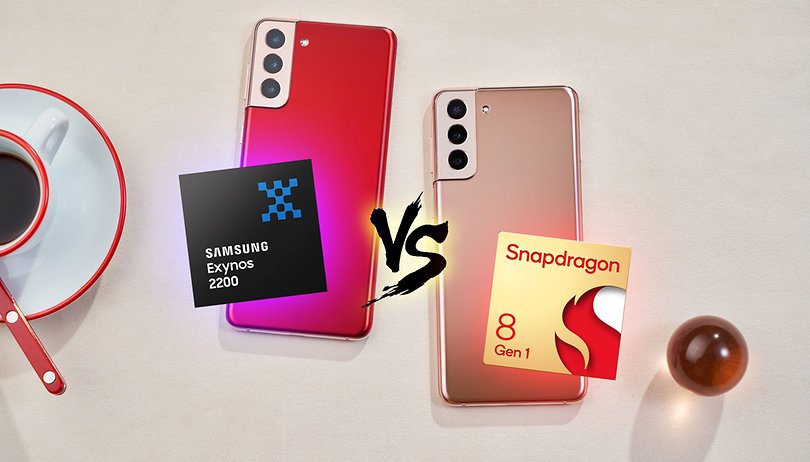

Read in other languages:
Last week Samsung pulled a weird move by not showing up to an event itself hyped days prior. But does the NextPit Community care about this whole Exynos vs Snapdragon matter? That's what we asked on last week's poll and now we have the results!
Outside a few canned messages to the press, Samsung - and its divisions - still didn't acknowledge its no-show last week for the unveiling of a new generation of its flagship SoC — unofficially known as Exynos 2200, codename s5e9925. If you trust the Geekbench database, there are signs that Samsung was trying to fine-tune the chip until the last minute, changing frequencies to a component expected to show up in less than a month.
When we asked the NextPit Community whether they were interested in Samsung LSI's announcement, the readers at the French domain were pretty divided, with a 36/36/29 split for the answers. Meanwhile, the German and English websites showed that most readers were not that interested in the announcement itself.
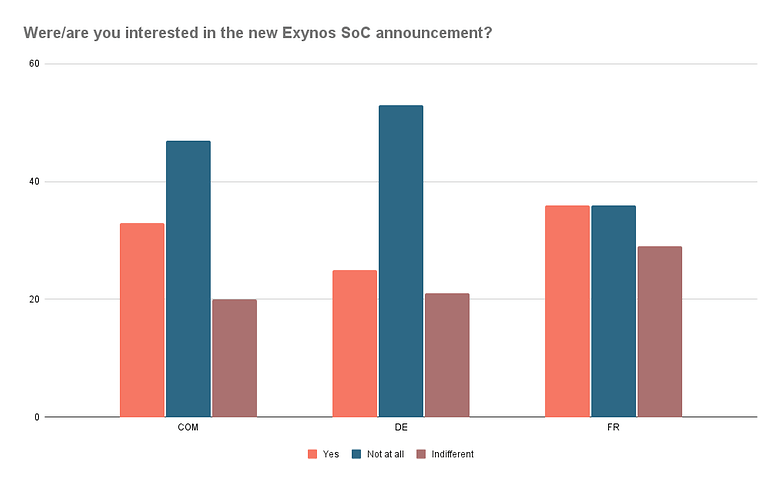
Playtime looks to remain unchanged
Asked about one of the headlining features of the new Exynos chip, its new AMD RDNA2 GPU, the Community was largely skeptical. The "won't revolutionize mobile gaming" answer was the most voted one in all domains, followed by the "Don't know/Too early to tell" option.
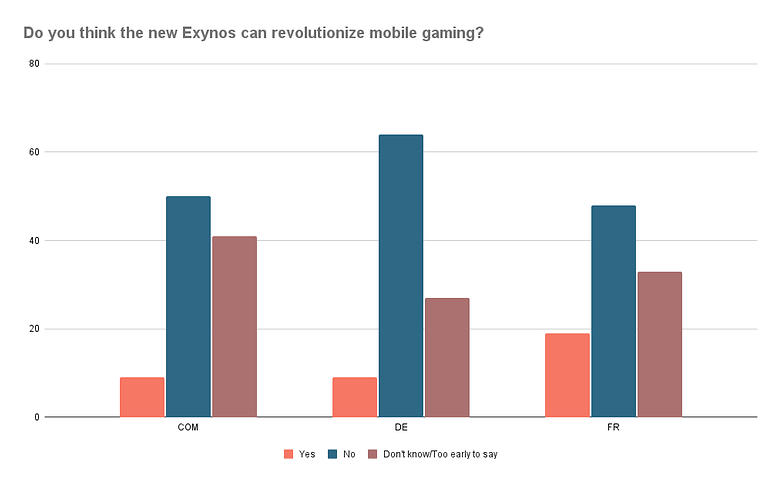
Reader Tim in the German website made a good point about the prospect of a new SoC changing the Android gaming market:
As long as they drive this stupid dual-processor trail, even a raytracing-compatible chip won't change anything at all, because developers can't even optimize their games for this single device series that uses the processor, because in the same devices in other markets using the QSD [Qualcomm Snapdragon]...
And the problem with the flagship Exynos models is made worse by the fact that it is not adopted by other brands, unlike some mid-range Exynos chips used in Vivo's and Meizu's phones, mostly in their Chinese versions.
The SoC-divide
Despite generally showing a lack of interest in the new Exynos chip, the majority of our readers answered they care about the Exynos vs Snapdragon debate, but with the French readers giving a slight advantage to the "don't care" answer.
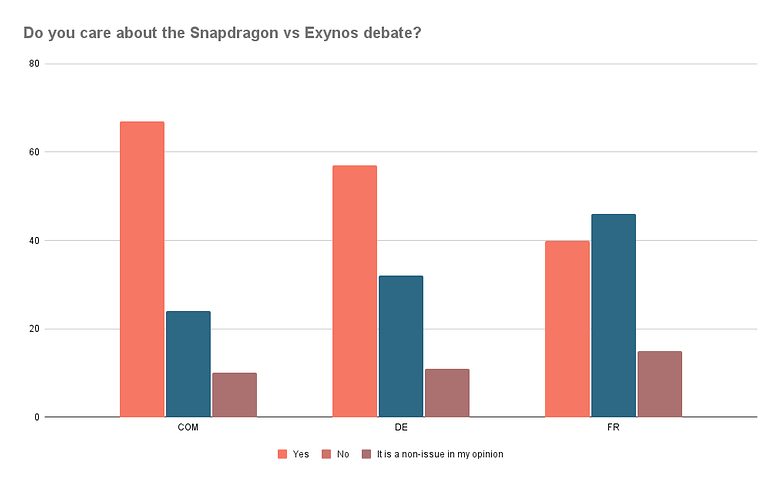
Conjo Man at the German website questioned Samsung Mobile's strategy of dual sourcing its flagship model's components, raising a very important point.
I don't really understand the (non)sense why Samsung has been doing two things all these years and using Snapdragon and Exynos SoCs.
After all, they have gained plenty of experience with their own SoCs, and they should use them 100% internationally in their smartphones.
Ultimately, this would also make programming and adjustments easier in the entire smartphone cosmos due to the uniform chip sets.
In the past, some publications questioned whether Samsung's use of the Snapdragon processors especially in the US was due to some concern with Qualcomm's modem patents, but last year, Google's Tensor SoC in the Pixel 6 line broke that supposed monopoly in the flagship market.
Readers Pirlo01 and Pierre Aubry on the French website made a pretty interesting (at least for me) discussion about whether last year's flagship SoCs problems were due to being manufactured by Samsung Foundry instead of Taiwanese TSMC — which is already overwhelmed by Apple processors in its transition to their own chips —, and if that could be an opportunity for the rise of MediaTek's Dimensity 9000 processor.
After all, nobody wants to see a bad product in the market, and as Tim pointed out in the comments, "Qualcomm simply needs more competition".
Thanks to everyone who voted for this week's poll and shared their views in the comments. We will keep you posted on any news regarding Samsung Semiconductor's new processor and, in the meantime, be sure to follow NextPit on Facebook, Twitter, and Telegram.
Original article
One of the strangest news this past week was Samsung’s no-show for its own Exynos event. The Korean company was expected to announce its new Exynos flagship SoC, debuting AMD’s GPU in the mobile space. Despite some strong opinions over the internet is it something that bothers the NextPit Community? Let’s find out!
At the end of 2021, Samsung LSI — the Korean Chaebol subsidiary responsible for designing processors — teased an announcement for January 11th with the hashtag #playtimeisover with a post over Twitter, a hotsite, and a video hosted on YouTube.
January 11th came and went with no signs of an announcement. In fact, on Monday (10th) we already noticed all three posts were deleted without warning, but thankfully you can find archived versions of the tweet, hotsite, and video on these links.

Powered by Radeon
One of the highlights of the new chip would be the new AMD RDNA2 GPU core on a mobile chip. The realization of an announcement made almost three years ago, the same GPU architecture is also used in the PlayStation 5 and Xbox Series consoles, of course with a higher core count than can be expected on a mobile SoC.
Rumors around leaked benchmarks suggested that the performance wasn’t up to the expectations of such a hyped product. Especially after Samsung partially blamed the usage of ARM’s Mali GPU on previous Exynos generations.
”The new GPU is expected to resolve the problems of the Exynos 2100. We intend to sharpen our competitiveness by loading GPUs for games into mobile devices.” said a Samsung representative to GSM Arena.
Adopting AMD’s GPU was expected to make the Exynos SoC leap ahead of the Snapdragon rival, with an unnamed model of the Adreno family — which traces its origins back to the Imageon mobile processors, bought by Qualcomm from ATI, before the GPU company was bought by AMD, one possible explanation for the fact that Adreno is an anagram for Radeon.

Snapdragon vs. Exynos: Hot chips
Even though the Exynos line lagged behind in the graphics performance for the past generations, it may seem a bit premature to blame it on the Mali GPUs. After all, Huawei’s Kirin 9000 SoC usually beats the Exynos 2100 chip, despite using the same Mali-G78 graphics, but with 24 cores instead of 14, and is reasonably competitive with the Snapdragon 888.
Still, with one of the most advanced GPUs on the market, the new Exynos is still expected to debut technologies that are exclusive to the PC and console markets, such as ray tracing. But their effectiveness is still unknown since we don’t know how they could work on an SoC limited by die size area, power usage, and heat dissipation.
In fact, power and heat are one of the problems plaguing the current generation of mobile processors, with throttling under heavy tasks like games to either prevent overheating or to keep battery usage under control.
And the Exynos line was often accused of having worse energy and thermal efficiency, something which NextPit showed when comparing the Samsung S20 FE models equipped with the Snapdragon 865 and Exynos 990 chips. Even though the gap was reduced with their successors in 2021 — both made with Samsung Foundry’s 5LPE process — sites like Anandtech found that the Snapdragon 888 is still slightly ahead of the Exynos 2100.
Apart from the graphics performance, there is the hurdle of making game developers adapt their games to use the new chip’s features. Since most companies try to reach the biggest number of players — and devices — in the market, it is not common to tailor games to flagship devices. Samsung could always fund developers to optimize games for the Exynos chips like Nvidia did with some exclusive Android ports for its Shield devices years ago, but with the Galaxy line also using Snapdragon chips, is it really a wise investment?
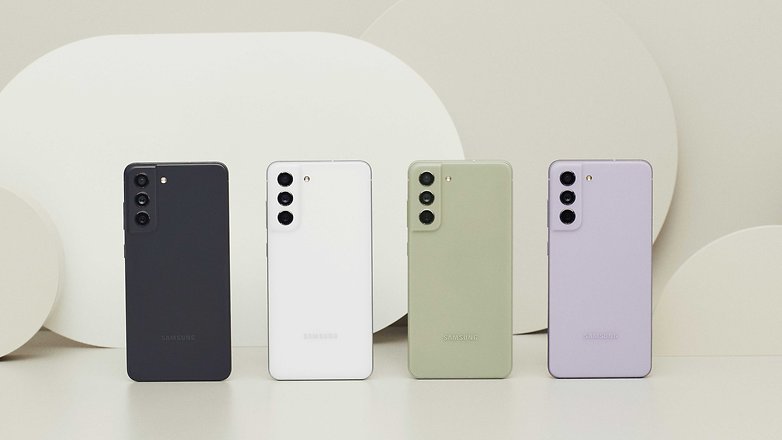
Is the Exynos really coming to the Galaxy S22?
The final question echoes a feeling that some of our European readers already shared in the comments. Samsung traditionally sells in Europe (and Latin America and most parts of Asia) its flagship line with a processor that is usually inferior to the one available in North American and Chinese models.
In the end, it is not feasible to opt for one version or another, which may have hurt Samsung’s mindshare between techies in the Old Continent. The recent launch of the Galaxy S21 FE with the Snapdragon 888 in developed countries may sign a change of the times (or simply better allocation of Qualcomm’s chips), but it is too early to tell.
Even so, January and February still keep the annual suspense of not knowing which market will receive which SoC. And even if the new Exynos will actually be used in the Galaxy S22 line after all. Despite some sites publishing that the Exynos 2200 will be announced with the flagship phones, Samsung’s reply to NextPit leaves the door open for the processor to be launched with any other model:
“Regarding [the] Exynos 2200 announcement, we're timing the release in line with the launch of a new smartphone.
As soon as the announcement is published following rescheduling, I’ll share it with you.”
BTW, the answer given to other sites omitted the chip’s name with a generic “application processor.” Like it or not, all signs indicate a new Exynos chip with AMD RDNA2 graphics is coming, but we will have to wait for shipping products to check if the hype was worth the attention.
After all this rambling, I leave you one last question for this week.
Thanks for staying with us up to this point, and sorry for rethreading things that we already covered on NextPit. But there is more to this page, so I invite you to add your views in the comments below. And I also invite you all to come back on Monday, when we will analyze the community votes.











